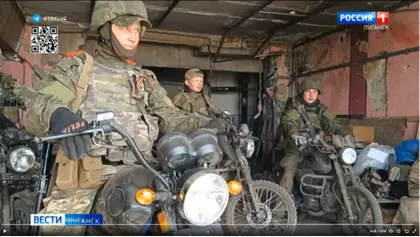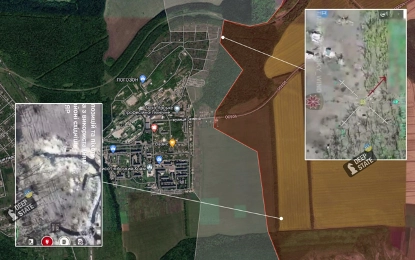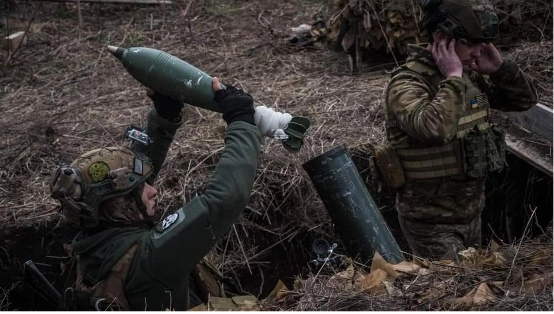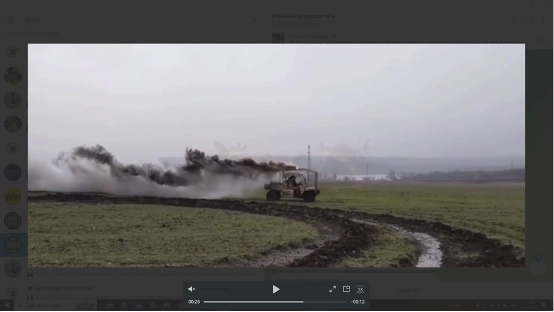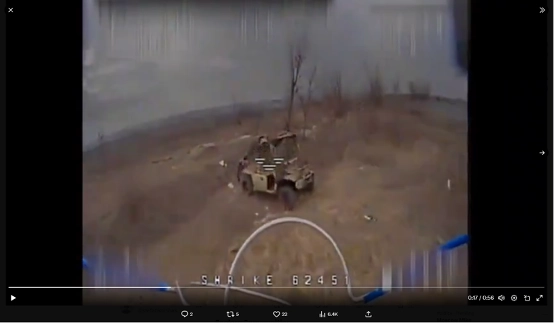Some Russian units have been employing unorthodox combat transport such as Chinese ATV and motorcycles to carry out attacks over the weekend, but it was conventional infantry supported by artillery that secured gains in the tactically important Chasiv Yar sector, according to mainstream and social media channels.
Images published by the pro-Russian Zarya militia unit, formed by residents of the so-called Luhansk People’s Republic (LNR), showed soldiers aboard motocross-type motorcycles advancing at speed across fields towards Ukrainian positions, facing no retaliatory fire. A unit spokesman claimed the Ukrainian artillery lacks ammunition to hit such fast-moving targets.
JOIN US ON TELEGRAM
Follow our coverage of the war on the @Kyivpost_official.
A follow-up report by Russia’s Vesti television news program, claimed the assault advanced Russia’s front line almost a kilometer. It reported that Ukrainian forces were unable to fire back during the high-paced attack because Russian drones and artillery pounded Ukrainian defensive positions forcing Kyiv’s troops to keep their heads down as they were assaulted by Moscow’s forces.
Kyiv Post assessment is that the images shown by Zarya and Vesti showed terrain similar to that west of Russia-controlled city Severodonetsk. Weekend situation reports published by Ukraine’s Army General Staff (AGS) did not report any Russian ground attacks in the sector other than a single assault on the village of Torsk, which was repelled.

Combatting Russia’s Shahed Blitz and What Trump’s Administration Should Do
The most intense fighting reported by either side over the past 72 hours was to the east of the Ukrainian-held town of Chasiv Yar, in the eastern Avdiivka sector.
According to multiple sources Russian infantry captured the nearby village of Bohdanivka and had moved into buildings on the eastern edge of Chasiv Yar. Ukrainian statements over the weekend confirmed substantial combat in the area but did not confirm loss of ground around Bohdanivka. On Saturday Armed Forces of Ukraine (AFU) spokesmen Nazar Voloshin said Russian troops were trying to break into Chasiv Yar “at any price,” and claimed Ukrainian forces were holding.
Deep State Battle showing the combat situation around Chasiv Yar on Monday. The Ukrainians hold the high ground but face superior Russian firepower.
The independent DeepState military information platform said Russian armored and infantry forces had advanced some two kilometers in the sector, but that their hold on Bohdanivka and the surrounding area had not been fully consolidated. Russian forces in the area were under Ukrainian fire, mostly by FPV drones and were having difficulty crossing the canal that blockins access into Chasiv Yar.
“The [vulgar Ukrainian word for Russians] continue to attack Chasiv Yar with infantry and rolling equipment. Some ba****ds even run to the canal, but they cannot get a foothold yet, and they die... battles are in progress around the settlements of Berdychi, Chasiv Yar, Staromaiske and Krasnohorivka.”
Monday’s AGS statement reported Ukrainian troops had repelled ten Russian ground assaults in the area of Chasiv Yar but did not mention the Bohdanivka village.
Chasiv Yar is tactically significant located as it is on high ground well-suited for defense. Once a rear area location not often under fire, Chasiv Yar became a keystone of Ukrainian defenses in eastern Donbas following Russian capture of the city of Bakhmut in May 2023. Russian attempts to advance westward since then have mostly stalled.
Bohdanivka is in low ground, but its buildings give some cover for attackers moving towards Chasiv Yar.
The Washington-based Institute for the Study of War (ISW) confirmed the Russian capture of Bohdanivka village and continuing Kremlin assaults in a Sunday situation update: “Russian forces recently made confirmed advances east of Chasiv Yar on April 14 and continued offensive operations in the area. Geolocated footage published on April 14 indicates that Russian forces advanced northeast of the Kanal Microraion [easternmost point of Chasiv Yar] and along a windbreak southeast of Chasiv Yar.”
Social media over the weekend reported that Russian units having participated in the assaults in the area included elite Russian paratroopers and special operations troops raised in the occupied Donetsk region.
According to Deep State and other open-source reports Ukraine’s 68th Mountain Assault Infantry Brigade, 67th Mechanized Infantry Brigade and 126th Territorial Defense Brigade are deployed to the Chasiv Yar sector. All are combat-seasoned units but likely to be suffering from personnel and ammunition shortages.
Ukraine’s Ground Forces commander, General Oleksandr Syrskiy, said in a Saturday statement that the Kremlin has ordered local commanders to capture Chasiv Yar by May 9 – a Russian public holiday that celebrates the end of fighting in Europe during World War Two.
The AFU has for months grappled with a worsening artillery ammunition deficit, according to some sources now almost total, because of delays in ammunition deliveries from European manufacturers and a US Congress failure to approve additional military aid to Ukraine since December; a move that ended some 18 months of strong US support to Kyiv.
Ukrainian mortarmen loads a precious 120mm round during combat in the Chasiv Yar/Bakhmut sector. Official Ukraine army photo, April 12.
Slow deliveries of anti-aircraft systems from western allies along with practically non-existent domestic production have likewise left AFU forces effectively unable to defend itself against Russian air strikes.
Weekend video from the Chasiv Yar and other sectors showed almost total Ukrainian reliance on crowd sourced FPV drones to attack Russian troops. The weapons are operated by volunteers and funded by public donations and so are not subject to political wrangling in other countries. They have increasingly become the AFU’s most effective defensive weapon. The cheap aircraft carry explosives are capable of taking out a multi-million-dollar tank or infantry fighting vehicle and have at times brought major Russian assaults to a total halt.
Russian counter-tactics to the Ukrainian drone threat have, along with placing troops on motorcycles, included welding anti-drone grates onto armored vehicles, rigging jammers with powerful generators on top of tanks, stringing nets over roads used by Russian vehicles, and issuing infantry with shotguns to shoot down the Ukrainian drones like clay pigeons.
These countermeasures have had limited success against Ukrainian operators flying drones between defensive panels on Russian vehicles, or breaking through Russian jamming with directional antennas and, most recently, mounting troops on fast motorcycles.
In mid-March Russian military information and official media platforms profiled Chinese four-wheel-drive ATVs, some rigged with smoke generators, intended to overcome Ukrainian drone swarms with speed and self-generated concealment. The gambit appears to have been unsuccessful with Ukrainian drone pilots attacking the Chinese “golf carts” from unexpected angles, or simply waiting for the vehicle to stop and then hitting it with several strikes.
According to Deep State and other open-source reports Ukraine’s 68th Mountain Assault Infantry Brigade, 67th Mechanized Infantry Brigade and 126th Territorial Defense Brigade are deployed to the Chasiv Yar sector. All are combat-seasoned units but likely to be suffering from personnel and ammunition shortages.
Ukraine’s Ground Forces commander, General Oleksandr Syrskiy, said in a Saturday statement that the Kremlin has ordered local commanders to capture Chasiv Yar by May 9 – a Russian public holiday that celebrates the end of fighting in Europe during World War Two.
The AFU has for months grappled with a worsening artillery ammunition deficit, according to some sources now almost total, because of delays in ammunition deliveries from European manufacturers and a US Congress failure to approve additional military aid to Ukraine since December; a move that ended some 18 months of strong US support to Kyiv.
Ukrainian mortarmen loads a precious 120mm round during combat in the Chasiv Yar/Bakhmut sector. Official Ukraine army photo, April 12.
Slow deliveries of anti-aircraft systems from western allies along with practically non-existent domestic production have likewise left AFU forces effectively unable to defend itself against Russian air strikes.
Weekend video from the Chasiv Yar and other sectors showed almost total Ukrainian reliance on crowd sourced FPV drones to attack Russian troops. The weapons are operated by volunteers and funded by public donations and so are not subject to political wrangling in other countries. They have increasingly become the AFU’s most effective defensive weapon. The cheap aircraft carry explosives are capable of taking out a multi-million-dollar tank or infantry fighting vehicle and have at times brought major Russian assaults to a total halt.
Russian counter-tactics to the Ukrainian drone threat have, along with placing troops on motorcycles, included welding anti-drone grates onto armored vehicles, rigging jammers with powerful generators on top of tanks, stringing nets over roads used by Russian vehicles, and issuing infantry with shotguns to shoot down the Ukrainian drones like clay pigeons.
These countermeasures have had limited success against Ukrainian operators flying drones between defensive panels on Russian vehicles, or breaking through Russian jamming with directional antennas and, most recently, mounting troops on fast motorcycles.
In mid-March Russian military information and official media platforms profiled Chinese four-wheel-drive ATVs, some rigged with smoke generators, intended to overcome Ukrainian drone swarms with speed and self-generated concealment. The gambit appears to have been unsuccessful with Ukrainian drone pilots attacking the Chinese “golf carts” from unexpected angles, or simply waiting for the vehicle to stop and then hitting it with several strikes.
Social media over the weekend reported that Russian units having participated in the assaults in the area included elite Russian paratroopers and special operations troops raised in the occupied Donetsk region.
Ukrainian drone about to hit and destroy a Russian Desertcross 1000-3 vehicle during combat in the Avdiivka sector. Screenshot UAF video, March 22.
You can also highlight the text and press Ctrl + Enter


